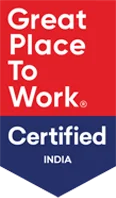Success Story
Migrating DB2 database to Oracle 19c for India’s leading insurance firm
Services used
About the client
With a history of over two decades, the client has established itself in the general insurance sector. Formed through a collaborative effort between a prominent Indian cooperative, known for its contributions to agriculture, and a leading Japanese insurance entity, our client has earned a reputation as a reliable partner.
Offering a range of insurance products covering vehicles, health, travel, and homes, the company is dedicated to serving a broad clientele, from small-scale farmers to large automobile manufacturers. Our client’s vision focuses on innovation, sustainability, and community engagement, aiming to contribute significantly to the future landscape of insurance services in India.
- 60TB of data migrated
- 100% system uptime during migration process
- 0% data loss
Business Situation
The client faced considerable operational challenges due to the substantial volume of data generated on a daily basis. As part of their routine interactions, thousands of insured individuals utilized the client’s application to submit crucial insurance policy-related documents and images. This consistent flow of documents became a significant hurdle for their internal team, straining the capabilities of their outdated content management system.
The existing Documentum-powered infrastructure struggled to cope with the daily influx of documents, creating inefficiencies in storage, importation, and viewing processes. The repercussions were evident in the form of slow response times, operational bottlenecks, and intermittent system downtime. These challenges collectively hindered the client’s capacity to provide seamless and timely customer service.
Recognizing the need for an immediate solution, the client aimed to upgrade its content management system to meet operational demands across its offices in India. However, no service provider was initially willing to undertake the challenging project due to the complexity and scale of the data management issue.
In this critical situation, Daffodil stepped forward and took on the challenge that others had turned down, showcasing a hands-on and determined approach to the project.
The key requirements were to:
- Enhance the existing EMC Documentum Content Management System, encompassing upgrades to both the Content Server and WebTop implementation.
- Migrate a substantial 60 TB content data from DB2 to Oracle, ensuring a smooth and efficient transition.
- Conduct the entire migration seamlessly, ensuring zero downtime due to the mission-critical nature of the live application data.
- Establish an AWS cloud environment and transition all archived data into AWS RDS, integrating it seamlessly with new Documentum Servers.
- Integrate the new database with client's ecosystem, including CRM systems, and facilitate the migration of SOAP-based services to REST API for improved interoperability and system efficiency.
- Deliver extensive support for a duration of one year, ensuring ongoing assistance and maintenance.
The Solution
Daffodil adopted a consulting approach with the client, during which our Cloud experts provided insights to their team regarding the limitations of the current state of the Documentum-powered Content Server and Documentum Client WebTop. It was discovered that both components were running on outdated versions—D7.2 for the content server and WebTop 6.x, respectively. These versions proved inefficient in managing a large volume of data within the Documentum repository, leading to issues such as performance lag, incompatibility, and increased demands on system resources.
Furthermore, during our assessment, we identified a critical aspect— Documentum had discontinued support for DB2 database, signaling the need for a proactive approach. In response, we recommended a strategic database migration from DB2 to Oracle 19c, presenting a solution that not only resolved immediate compatibility challenges but enhanced system performance and long-term sustainability.
Our expert team started with the requirement gathering process and conducted a comprehensive impact analysis of both the client and server upgrade. We examined the system sizing, encompassing both logical and physical architecture, to ensure it could effectively handle the requirements of Documentum stake. With all this information documented and a solidified roadmap in place, the Daffodil team initiated the upgradation and migration process. This involved leveraging Documentum Webtop suite, Oracle DB, Java/J2EE, and Documentum APIs.

Content server upgrade from D7.2 to D 20.2
To ameliorate the existing EMC Documentum Content Management System, our development team commenced with comprehensive planning, including the review of release notes and the evaluation of existing customizations, specific to the D7.2 version. A test environment, mirroring the production setup, was then established for rigorous testing. During the upgrade, database schema and software installations were performed, configurations were updated, and customizations were applied for compatibility with CS D 20.2. Thorough testing in the test environment validated the success of the upgrade, assuring that critical functionalities were preserved.

WebTop upgrade from 7.2 to 20.2
The Daffodil team conducted an in-depth study of the existing WebTop application, analyzing interfaces, and configurations such as roles, groups, and document types. This detailed review ensured a clear understanding of the current state and informed the upgrade strategy.
As part of the upgrade, we utilized Webtop Project Admin and the project import/export module. This approach facilitated the deployment of the same configurations in the WebTop 16.7.4 application. The team carefully applied customizations, adjusted configurations, and executed extensive testing in the test environment to validate the seamless transition of interfaces and configurations.
A backup and rollback strategy was established, and database schema changes specific to the upgrade were executed. User acceptance testing, involving stakeholders, also validated that existing functionalities, configurations, and interfaces aligned with expectations.

Database server migration: moving from DB2 to Oracle 19c
In response to the client’s significant 60 TB of data within the existing DB2 database, our development team opted for a strategic migration to Oracle 19c, leveraging Oracle’s robust capabilities for handling large datasets and proven scalability. Our approach began with a thorough analysis of the database structure, ensuring a clear understanding of the relationships and dependencies.
The migration planning phase emphasized the critical task of mapping data from DB2 to Oracle, identifying any required data transformations. During execution, the team seamlessly extracted, transformed, and loaded data into Oracle, leveraging optimized loading mechanisms.
The deployment to production was executed with a carefully scheduled downtime, ensuring that all migration activities were performed with zero downtime—a critical consideration given that the data resided in a mission-critical live application.

Building in-house utility for smooth data migration
One of the major hurdles we encountered in the migration process was dealing with the disparity in data types between the DB2 and Oracle databases, creating a compatibility challenge. To navigate this hurdle, our team implemented a methodical approach. Initially, we moved the DB2 database to a local one, where our experts manually mapped fields with the required Oracle format. Subsequently, utilizing our in-house utility, we transferred this refined local database to Oracle, ensuring data integrity throughout the process.
In an effort to optimize cloud storage expenses, we advised our client to migrate this refined dataset to the Oracle instance on AWS RDS, leveraging the robust capabilities of Amazon’s cloud servers. Our team efficiently integrated the data with upgraded Documentum servers, managing tasks such as provisioning AWS instances, implementing robust security measures, and ensuring seamless compatibility between Documentum and AWS RDS for efficient data archival.
The adoption of AWS cloud services not only led to a reduction in storage costs but also delivered enhanced scalability and performance for our client’s Documentum servers. Through extensive documentation and knowledge-sharing sessions, our team empowered the client’s operations team with the skills required to effectively manage the newly integrated AWS Cloud environment.

Captiva scanning tool
Our team also installed and configured the Captiva scanning tool to enhance document processing for our client. This tool was integrated into the client’s platform to streamline the insurance application process by automatically scanning and extracting crucial details from various user-submitted documents.
Captiva excelled not only in scanning text documents but also in analyzing images. For instance, when users uploaded documents such as PAN cards, insurance application forms, and images of vehicles, Captiva scanned both text and images. It automatically extracted details, such as PAN card numbers and vehicle registration information, efficiently indexing this data within the system.
The team seamlessly configured the Captiva scanning tool with the upgraded content server, ensuring its seamless operation on stored data when needed. This tool significantly streamlined the document management process, alleviating manual efforts for the internal team.

The Impact
The upgraded content management system significantly enhanced client's day-to-day operations. Running on Documentum 20.2, the system operated more smoothly, eliminating previous bottlenecks and slowdowns. Additionally, the strategic migration from DB2 to Oracle 19c, coupled with an operating system upgrade, ensured optimal system performance. This success positioned our client as a more responsive and efficient insurance provider. Impressed by our dedication and positive results, the client was enthusiastic about entrusting us with new projects. This trust was further manifested when they offered us the opportunity to upgrade the Captiva tool to align with Oracle 19c, marking another milestone in our successful collaboration.
Read Related Case Studies
Get in Touch
Sign up for a 30 min no-obligation strategic session with us
Let us understand your business objectives, set up initial milestones, and plan your software project.
At the end of this 30 min session, walk out with:
- Validation of your project idea/ scope of your project
- Actionable insights on which technology would suit your requirements
- Industry specific best practices that can be applied to your project
- Implementation and engagement plan of action
- Ballpark estimate and time-frame for development








